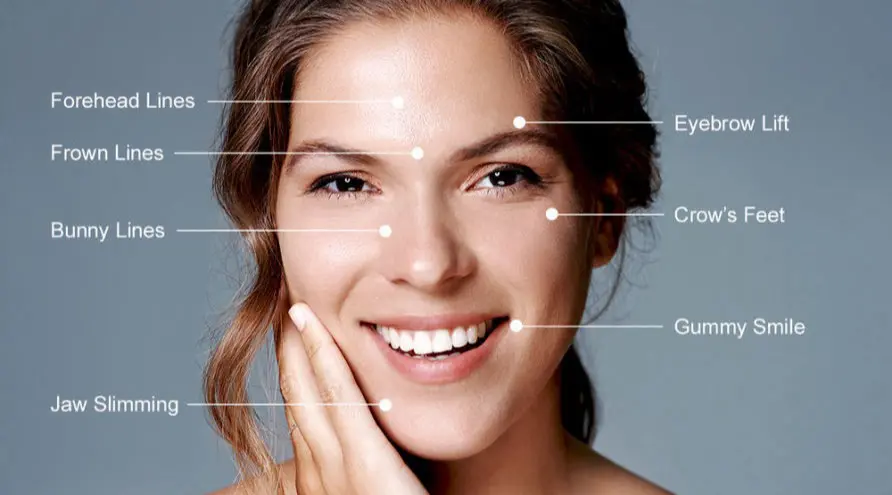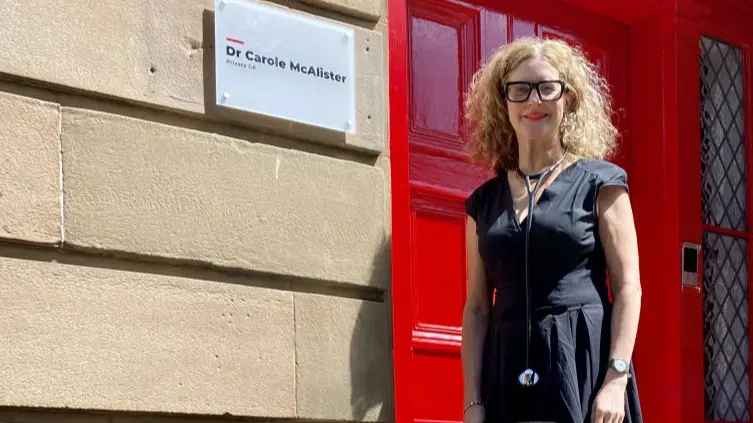BOTOX® IMPORTANT SAFETY INFORMATION
BOTOX® and BOTOX® Cosmetic may cause serious side effects that can be life threatening. Get medical help right away if you have any of these problems any time (hours to weeks) after injection of BOTOX® or BOTOX® Cosmetic:
Problems swallowing, speaking, or breathing, due to weakening of associated muscles, can be severe and result in loss of life. You are at the highest risk if these problems are preexisting before injection. Swallowing problems may last for several months
Spread of toxin effects. The effect of botulinum toxin may affect areas away from the injection site and cause serious symptoms, including loss of strength and all-over muscle weakness; double vision; blurred vision; drooping eyelids; hoarseness or change or loss of voice; trouble saying words clearly; loss of bladder control; trouble breathing; and trouble swallowing
There has not been a confirmed serious case of spread of toxin effect away from the injection site when BOTOX® has been used at the recommended dose to treat Chronic Migraine, severe underarm sweating, Blepharospasm, Strabismus, or when BOTOX® Cosmetic has been used at the recommended dose to treat frown lines, crow’s feet lines, and/or forehead lines.
Indications
BOTOX® is a prescription medicine that is injected into muscles and used:
To treat overactive bladder symptoms such as a strong need to urinate with leaking or wetting accidents (urge urinary incontinence), a strong need to urinate right away (urgency), and urinating often (frequency) in adults 18 years and older when another type of medicine (anticholinergic) does not work well enough or cannot be taken
To treat leakage of urine (incontinence) in adults 18 years and older with overactive bladder caused by a neurologic disease who still have leakage or cannot tolerate the side effects after trying an anticholinergic medication
To treat overactive bladder due to a neurologic disease in children 5 years of age and older when another type of medicine (anticholinergic) does not work well enough or cannot be taken
To prevent headaches in adults with Chronic Migraine who have 15 or more days each month with headache lasting 4 or more hours each day in people 18 years or older
To treat increased muscle stiffness in people 2 years of age and older with spasticity
To treat the abnormal head position and neck pain that happens with Cervical Dystonia (CD) in people 16 years and older
To treat certain types of eye muscle problems (Strabismus) or abnormal spasm of the eyelids (Blepharospasm) in people 12 years of age and older
BOTOX® is also injected into the skin to treat the symptoms of severe underarm sweating (severe primary axillary hyperhidrosis) when medicines used on the skin (topical) do not work well enough in people 18 years and older.
BOTOX® Cosmetic is a prescription medicine that is injected into muscles and used to temporarily improve the look of moderate to severe forehead lines, crow’s feet lines, and frown lines between the eyebrows in adults.
It is not known whether BOTOX® and BOTOX® Cosmetic are safe and effective to prevent headaches in patients with migraine who have 14 or fewer headache days each month (episodic migraine).
BOTOX® has not been shown to help people perform task-specific functions with their upper limbs or increase movement in joints that are permanently fixed in position by stiff muscles.
It is not known whether BOTOX® and BOTOX® Cosmetic are safe and effective for severe sweating anywhere other than your armpits.
It is not known if BOTOX® Cosmetic is safe and effective for use more than 1 time every 3 months.
BOTOX® and BOTOX® Cosmetic may cause loss of strength or general muscle weakness, vision problems, or dizziness within hours to weeks of receiving BOTOX® or BOTOX® Cosmetic. If this happens, do not drive a car, operate machinery, or do other dangerous activities.
Do not receive BOTOX® or BOTOX® Cosmetic if you are allergic to any of its ingredients (see Medication Guide for ingredients); had an allergic reaction to any other botulinum toxin product such as Myobloc® (rimabotulinumtoxinB), Dysport® (abobotulinumtoxinA), or Xeomin® (incobotulinumtoxinA); have a skin infection at the planned injection site.
Do not receive BOTOX® for the treatment of urinary incontinence if you have a urinary tract infection (UTI) or cannot empty your bladder on your own and are not routinely catheterizing. Due to the risk of urinary retention (difficulty fully emptying the bladder), only patients who are willing and able to initiate catheterization posttreatment, if required, should be considered for treatment.
Patients treated for overactive bladder: In clinical trials, 36 of the 552 patients had to self-catheterize for urinary retention following treatment with BOTOX® compared to 2 of the 542 treated with placebo. The median duration of postinjection catheterization for these patients treated with BOTOX® 100 Units (n = 36) was 63 days (minimum 1 day to maximum 214 days), as compared to a median duration of 11 days (minimum 3 days to maximum 18 days) for patients receiving placebo (n = 2). Patients with diabetes mellitus treated with BOTOX® were more likely to develop urinary retention than nondiabetics.
Adult patients treated for overactive bladder due to neurologic disease: In clinical trials, 30.6% of adult patients (33/108) who were not using clean intermittent catheterization (CIC) prior to injection, required catheterization for urinary retention following treatment with BOTOX® 200 Units as compared to 6.7% of patients (7/104) treated with placebo. The median duration of postinjection catheterization for these patients treated with BOTOX® 200 Units (n = 33) was 289 days (minimum 1 day to maximum 530 days) as compared to a median duration of 358 days (minimum 2 days to maximum 379 days) for patients receiving placebo (n = 7).
Among adult patients not using CIC at baseline, those with MS were more likely to require CIC post injection than those with SCI.
The dose of BOTOX® and BOTOX® Cosmetic is not the same as, or comparable to, any other botulinum toxin product.
Serious and/or immediate allergic reactions have been reported, including itching, rash, red itchy welts, wheezing, asthma symptoms, dizziness, or feeling faint. Get medical help right away if you experience symptoms; further injection of BOTOX® or BOTOX® Cosmetic should be discontinued.
Tell your doctor about all your muscle or nerve conditions, such as ALS or Lou Gehrig’s disease, myasthenia gravis, or Lambert-Eaton syndrome, as you may be at increased risk of serious side effects, including difficulty swallowing and difficulty breathing from typical doses of BOTOX® or BOTOX® Cosmetic.
Tell your doctor if you have any breathing-related problems. Your doctor may monitor you for breathing problems during treatment with BOTOX® for spasticity or for detrusor overactivity associated with a neurologic condition. The risk of developing lung disease in patients with reduced lung function is increased in patients receiving BOTOX®.
Cornea problems have been reported. Cornea (surface of the eye) problems have been reported in some people receiving BOTOX® for their Blepharospasm, especially in people with certain nerve disorders. BOTOX® may cause the eyelids to blink less, which could lead to the surface of the eye being exposed to air more than is usual. Tell your doctor if you experience any problems with your eyes while receiving BOTOX®. Your doctor may treat your eyes with drops, ointments, contact lenses, or with an eye patch.
Bleeding behind the eye has been reported. Bleeding behind the eyeball has been reported in some people receiving BOTOX® for their Strabismus. Tell your doctor if you notice any new visual problems while receiving BOTOX®.
Bronchitis and upper respiratory tract infections (common colds) have been reported. Bronchitis was reported more frequently in adults receiving BOTOX® for upper limb spasticity. Upper respiratory infections were also reported more frequently in adults with prior breathing-related problems with spasticity. In pediatric patients treated with BOTOX® for upper limb spasticity, upper respiratory tract infections were reported more frequently. In pediatric patients treated with BOTOX® for lower limb spasticity, upper respiratory tract infections were not reported more frequently than placebo.
Autonomic dysreflexia in patients treated for overactive bladder due to a neurologic disease. Autonomic dysreflexia associated with intradetrusor injections of BOTOX® could occur in patients treated for detrusor overactivity associated with a neurologic condition and may require prompt medical therapy. In clinical trials, the incidence of autonomic dysreflexia was greater in adult patients treated with BOTOX® 200 Units compared with placebo (1.5% versus 0.4%, respectively).
Tell your doctor about all your medical conditions, including if you have or have had bleeding problems; have plans to have surgery; had surgery on your face; have weakness of forehead muscles, trouble raising your eyebrows, drooping eyelids, and any other abnormal facial change; have symptoms of a urinary tract infection (UTI) and are being treated for urinary incontinence (symptoms of a urinary tract infection may include pain or burning with urination, frequent urination, or fever); have problems emptying your bladder on your own and are being treated for urinary incontinence; are pregnant or plan to become pregnant (it is not known if BOTOX® or BOTOX® Cosmetic can harm your unborn baby); are breastfeeding or plan to (it is not known if BOTOX® or BOTOX® Cosmetic passes into breast milk).
Tell your doctor about all the medicines you take, including prescription and over-the-counter medicines, vitamins, and herbal supplements. Using BOTOX® or BOTOX® Cosmetic with certain other medicines may cause serious side effects. Do not start any new medicines until you have told your doctor that you have received BOTOX® or BOTOX® Cosmetic in the past.
Tell your doctor if you have received any other botulinum toxin product in the last 4 months; have received injections of botulinum toxin such as Myobloc®, Dysport®, or Xeomin® in the past (tell your doctor exactly which product you received); have recently received an antibiotic by injection; take muscle relaxants; take an allergy or cold medicine; take a sleep medicine; take aspirin-like products or blood thinners.
Other side effects of BOTOX® and BOTOX® Cosmetic include dry mouth, discomfort or pain at the injection site; tiredness; headache; neck pain; eye problems such as double vision, blurred vision, decreased eyesight, drooping eyelids, swelling of your eyelids, dry eyes; drooping eyebrows; and upper respiratory tract infection. In adults being treated for urinary incontinence, other side effects include urinary tract infection and painful urination. In children being treated for urinary incontinence, other side effects include urinary tract infection and bacteria in the urine. If you have difficulty fully emptying your bladder on your own after receiving BOTOX®, you may need to use disposable self-catheters to empty your bladder up to a few times each day until your bladder is able to start emptying again.
For more information refer to the Medication Guide or talk with your doctor.
Please see BOTOX® full Product Information, including Boxed Warning and Medication Guide.
Please see BOTOX® Cosmetic full Product Information, including Boxed Warning and Medication Guide.


